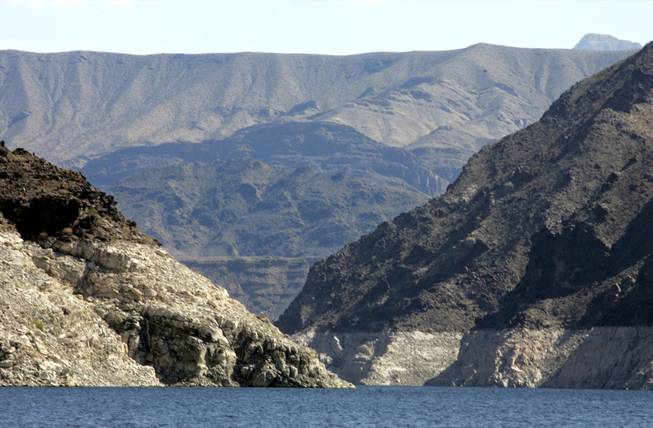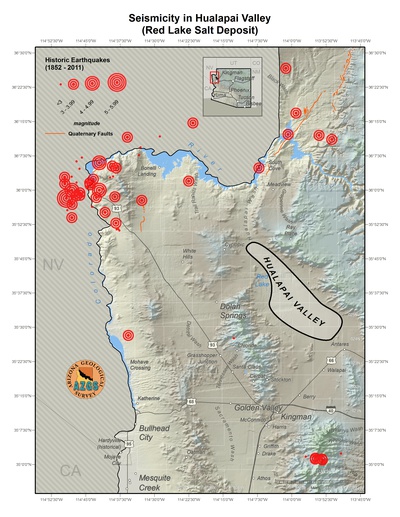
Sam Morris / Sun file photo
Discoloration around the banks of Lake Mead shows how much the water level has declined over the years.
Thursday, Jan. 5, 2012 | 2 a.m.
All that Colorado snow runoff that poured into Lake Mead last spring and summer may have done more than raise the water level.
It may have triggered the earth to quake beneath the lake.
Lee Allison, Arizona state geologist and director of the state’s geological survey, said he began to notice the small quakes — ranging in magnitude from 1.5 to 2.2 — in late April. He tallied about two dozen in the months that followed and blogged about many as they occurred.
“I saw more (seismic activity) there than in the past five years,” Allison said.
There was about one small quake a week, and three occurred on one day in July.
“At that point we were going, ‘Ha, interesting,’” he said.
The seismic activity became a topic of speculation among Allison and his colleagues when someone tried to connect the dots by suggesting the quakes were triggered by the Rocky Mountain snowmelt rapidly filling the lake.
Allison admits his observations amount to nothing more than informed speculation at this point. And some experts believe there might be other explanations, including blasting at Southern Nevada quarries.
“This would be a great thesis project,” Allison said. “We’d like to do more research on it.”
Scientists have documented a relationship between lake fluctuations and movements in the earth’s crust, including at Lake Mead.
“When Lake Mead was filled in the 1930s, there were a number of magnitude-5 earthquakes, most likely directly associated with the filling of the lake,” said Ken Smith, seismic network manager at UNR.
One of Smith’s colleagues at the Nevada Seismological Laboratory, Graham Kent, published a scientific paper last year arguing that California’s Salton Sea has triggered large quakes along the southern San Andreas Fault. Some scientists speculate that China’s 8-magnitude Sichuan quake in 2008 might have been caused by the filling of the Zipingpu Dam.
Water “alters the states of stress” on the earth’s crust, Kent said, calling it a “hot topic of research.”
Lake Mead has seen a lot of water recently.
Today, the lake holds 4.8 million acre feet more than it did at its low point, in November 2010, according to the Southern Nevada Water Authority.
The weight of that additional 1.6 trillion gallons? 6.5 billion tons.
Since Allison floated his hypothesis, others have dug into the data.
One of Allison’s colleagues noted that Lake Mead experienced elevated seismicity compared with the area before the dam was built and continuing until the mid-1960s. The shaking “correlated fairly well, but not perfectly,” with high lake levels, Allison wrote on his blog.
This subsided, he said, around the time Lake Powell came online and helped even out the flow of water into Lake Mead.
But Smith isn’t ready to sign onto Allison’s hypothesis. He said he noticed some of the small quakes Allison cites as part of the trend, in particular one in early September, coincided with blasting at a nearby quarry.
“They’re very large explosions, and sometimes they occur daily,” Smith said.
He added that there were two quakes near the lake in 2009 and 2010 that were larger than last year’s. The shaking was felt in the eastern valley.
“It’s not unusual to have magnitude-4 type events in that area,” Smith said. “It’s not surprising to see earthquakes anywhere in Nevada.”


Join the Discussion:
Check this out for a full explanation of our conversion to the LiveFyre commenting system and instructions on how to sign up for an account.
Full comments policy